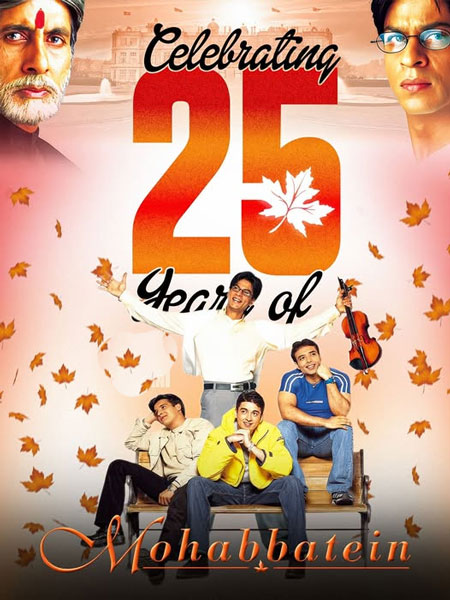Daijiworld Media Network – Mumbai
Mumbai, Oct 27: Love versus discipline, ego versus sentiment — and Shah Rukh Khan versus Amitabh Bachchan. When the world stepped into the new millennium in 2000, Bollywood celebrated the moment with an unforgettable face-off of two megastars through Aditya Chopra’s romantic drama ‘Mohabbatein’. The film, which turns 25 today, remains a defining moment in Hindi cinema — a bridge between generations, ideologies, and stardom itself.
At the time of its release, Shah Rukh Khan was 35, the reigning king of romance, while Amitabh Bachchan, nearing 60, was reinventing himself after the end of his Angry Young Man era. The film became a symbol of changing cinematic tides — where love dared to challenge tradition.

Aditya Chopra’s vision: Stardom as storytelling
After delivering the blockbuster Dilwale Dulhania Le Jayenge in 1995, Aditya Chopra took five years to direct his next. With Mohabbatein, he revisited familiar themes — love versus patriarchal rigidity — but with a bigger emotional and visual canvas.
In an era untouched by social media, star power ruled the box office, and Chopra smartly brought together two of India’s most powerful cinematic forces. The result was a timeless story of emotional rebellion.
Two titans, two ideologies
Amitabh Bachchan played Narayan Shankar, the strict principal of Gurukul, a symbol of order and authority who believed in “Parampara, Pratishtha, Anushasan.” Love was a forbidden emotion within his walls.
Opposite him, Shah Rukh Khan essayed Raj Aryan Malhotra, a warm, rule-breaking music teacher who dared to confront Narayan’s rigid beliefs. Raj’s character — a man whose love had once been crushed by Gurukul’s rules — symbolized compassion and change.
Generational contrast and emotional power
Casting Bachchan and Khan together was a cinematic masterstroke, blending two eras of stardom. Bachchan, the emblem of the ’70s and ’80s, transitioned to mature roles, while Khan redefined the romantic hero archetype of modern Hindi cinema.
The film also introduced six new faces, including Uday Chopra, Shamita Shetty, Kim Sharma, Preeti Jhangiani, and Jugal Hansraj, adding youthful vibrance to the story. Raj Aryan acted as a mentor to the young couples, guiding them through love, rebellion, and loss.
The iconic confrontation
One of Bollywood’s most powerful cinematic moments remains the confrontation between Narayan and Raj — a verbal duel rich in emotion and ideology.
Raj’s poignant lines —
“Maaf kijiye sir, par jahaan se main dekh raha hoon, aap haar gaye...” —
still echo among fans, while Narayan’s unyielding motto —
“Parampara, Pratishtha, Anushasan” —
stands as one of Hindi cinema’s most memorable dialogues.
Rivalry and respect beyond the screen
Over the years, fans and media often speculated about an SRK–Big B rivalry, especially after Shah Rukh took over Kaun Banega Crorepati and starred in Don’s remake. However, SRK clarified in interviews that such rivalries were “media-generated,” saying, “We are cultured, graceful people doing well in our professions… It’s more embarrassing than anything else.”
On Mohabbatein’s 20th anniversary, SRK fondly recalled, “I remember doing the first scene with Amitabh Bachchan and realizing how short and small I am.”
Legacy and evolution
Twenty-five years later, as the industry adapts to an age of short-form content and digital storytelling, Mohabbatein stands as a reminder of cinema’s emotional grandeur.
Interestingly, Aditya Chopra’s latest production, Saiyaara, mentored by him under Yash Raj Films, has introduced a new generation of stars — echoing how Mohabbatein once did.
In 2000, Aditya Chopra proved that when stardom meets storytelling, cinema transcends generations.
‘Mohabbatein’ wasn’t just a film — it was an era-defining statement on love, loss, and legacy.